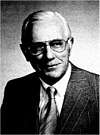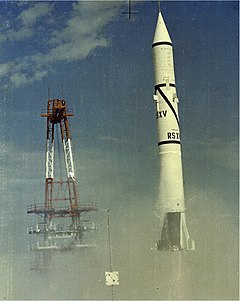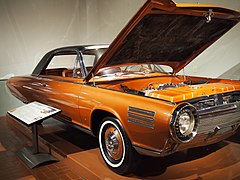George Huebner
George John Huebner Jr. (September 8, 1910 – February 19, 1996) was an American executive engineer who worked for the Chrysler Corporation. While in his twenties he worked for the Central Engineering Division at Chrysler developing new technology in mechanical engineering using science. It was long-term concepts he worked on that didn't come to fruition for some ten to twenty years. He researched an experimental gas turbine engine for passenger automobiles. A version of this engine was later installed and used as the main motorization for certain military tanks worldwide.
George Huebner | |
|---|---|
 | |
| Born | George John Huebner Jr. September 8, 1910 |
| Died | September 4, 1996 (aged 85) |
| Nationality | American |
| Occupation | Engineer |
| Known for | turbine engines |
Notable work | turbine engine automobile |
Huebner was put in charge of Chrysler's new Missile Branch division in the 1950s as executive engineer. He organized a missile research and development facility. The Corporation ultimately engineered out the Redstone rocket, which was used in the Unites States aerospace industry to place permanent satellites in orbit and for space travel. He worked with the rocket scientist Wernher von Braun on these developments.
Early-life and education
Huebner was born in Detroit, Michigan, on September 8, 1910.[1] He was the son of George John Huebner (Sr) and Ruth Reigel Huebner.[2] His father was a stockbroker and published Tooling and Production magazine.[3] His grandfather was an automobile parts dealer and many times sold parts and material to Henry Ford.[4] His great grandfather immigrated to America from Germany in 1815 bringing old sea chests with him.[4]
Huebner was a high achiever in the Detroit public schools and attended Principia High School of Missouri.[4] He enrolled at the University of Michigan when sixteen years old.[4] His first classes were in economics, taken with an intention to follow in his father's footsteps as a stockbroker.[4] He was for awhile a stock broker with his own firm starting in 1930.[5] He later became interested in mechanical engineering with the association of his father's friend Harold S. Ellington, a consulting engineer. He changed his major at the University of Michigan which extended his studies. He graduated with a bachelor's degree in engineering in 1932.[4][6][7]
Mid-life and career
Huebner joined Chrysler Corporation in Detroit part-time in 1931 before graduating from the university a year later.[8][9] He was, at first, a research engineer and, in 1936, became assistant chief engineer at the age of 26.[7][10][11] He held that position until 1939 when he went to the Central Engineering Division within Chrysler Corporation to work as assistant to Carl Breer, one of the core engineers of 15 years before.[7][12] Breer inspired him to look into future technology, which lead him into technology that involved mechanical engineering enhanced by science. Huebner worked on advanced concepts with longer-term objectives that were expected to take ten to twenty years to achieve. This eventually lead him to the idea of developing a gas turbine engine because of the pure and applied science involved in such a sophisticated machine.[13]

.jpg)

One of Huebner's first jobs at the Central Engineering Division within Chrysler was working on aircraft turbine engines.[6] He designed in May 1940, with a group of engineers he directed, a liquid-cooled V-16 fighter aircraft engine called the XI-2220 that had 2,500 horsepower.[14] It was flight tested in a Republic P-47 Thunderbolt fighter aircraft, but never manufactured and its development was discontinued in 1945 because World War II ended and it was no longer needed.[14]
Chrysler reorganized their research department in 1946 and Huebner was made chief engineer.[15] Chrysler then started research on a regenerative recuperative turbine design after the XI-2220 engine development came to a stop. The new engine was given the designation A-86.[14] The U.S. Navy gave Chrysler a contract for the design of a 1,000-horsepower turboprop aircraft engine based off the A-86 of which Huebner was the main engineer in charge of its research and development. Four test engines were built by 1949 but never used in a Navy aircraft and no further progress came about.[14]
Rocket engines
Chrysler was awarded a contract from the United States Army Ordnance Corps in 1952 to produce a guided missile.[15] Huebner served as executive engineer in charge of Chrysler's Missile Branch beginning in 1953,[16] while still assigned to Chrysler's automotive research division.[14] He developed in Detroit a complete research and development missile facility[17][18] that included engineering, testing, and production of the Redstone rocket.[19][20] These rockets ultimately launched into orbit the first U.S. satellites and the first manned space flights. Huebner worked closely with Wernher von Braun on the space program.[21] For two years he worked on this rocket project and then went back to automotive research.[19] Huebner described his rocket days in a 1959 Boys' Life magazine article titled "Rehearsal for Space" that was spread out over 3 pages for his complete story.[22]
Turbine engines
Huebner, as chief engineer of Chrysler's research division developing experimental automobiles, was in charge of gas turbine engine design for road vehicles.[23] He became Director of Research in 1955.[24] His main job was the design of an automobile V-8 engine with a hemispherical combustion chamber.[25] Huebner, as research engineer at the Chrysler Corporation, directed a project in 1956 of the first transcontinental trip in a gas-turbine automobile.[26][27][28] A production sedan automobile was used and fitted with a gas turbine engine of his design.[29][30][31] It became known as the Chrysler Turbine Special.[32][33] It was a converted 1956 Plymouth Belvedere.[34][35]
Huebner drove the special turbine engine automobile himself across the United States. He left New York City with his driving crew on Monday March 26, 1956 and traveled 3,000 mi (4,830 km) on the nation's highways with a support caravan of station wagons of equipment. The trip involved going through Pittsburgh, Indianapolis, St. Louis, Amarillo, Albuquerque, and Flagstaff. Huebner arrived four days later in Los Angeles on Friday evening March 30.[34][36] The trip of the gas turbine car ran on white gasoline, fuel oil, and diesel oil.[37] Sometimes normal leaded gasoline, as used in piston automobiles, was burned as a fuel.[38] It was driven at 55 miles per hour (89 km/h) most of the time and averaged 45 miles per hour (72 km/h) for the total trip. Using conventional gasoline it averaged 13 to 14 miles per US gallon (18 to 17 l/100 km), but with kerosene usage it was claimed that it could have averaged 18 miles per US gallon (13 l/100 km).[33][38]
Chrysler, with Huebner as their director of research, displayed an experimental turbine-driven automobile in 1961.[39] The company made 50 experimental turbine-powered automobiles in 1963. The two-year test had inconclusive results and several problems noted.[40] A complaint from the test drivers was that the engine had an annoying whine to it when driven below 60 miles per hour (97 km/h). Another complaint was that there was a lag in acceleration.[41] The major stumbling block to mass production was its poor fuel economy of 11.5 miles per US gallon (20.5 l/100 km).[42] There were six generations of experimental turbine automobiles between 1950 and 1970 where Huebner was the director.[43]
Huebner's research included that of the development of adhesives, radioactive isotopes, sonic oil well drills, exhaust catalysts, and instruments to measure hydrocarbons and carbon monoxide in exhaust emissions.[44] He held forty patents on various inventions related to turbine engines.[44] He wrote seventeen technical engineering papers.[44] Huebner took on the additional duty of becoming president of the Chrysler Institute of Engineering in 1960, a postgraduate school for engineers that he had until his retirement.[44][45]
Huebner was honored with a 1960 Buckendale Award of 7,000 Society of Automobile Engineers meeting in January of 1960 based on his computer-based technology he developed for the industry.[7][46] In 1962 he was honored at a special celebration of American Society of Mechanical Engineers for his leadership in developing the technology for potential mass-produced turbine passenger automobiles.[19][47][48]

Other research
Huebner believed he had put in motion the idea that a gas turbine car was going to be the trend and the conventional automobile would be replaced by this technology.[49] Chrysler continued to develop the automobile turbine engine through the mid-1960s thinking it would revolutionize passenger car design.[50] During Huebner's career a gas turbine automobile of his design was never mass-produced for the public.[51] They were too expensive for the average car owner.[52] Chrysler had a version of Huebner's turbine engine installed into the Abrams military tank that is the main battle tank for the United States and other countries.[53]
Later life, legacy, and death
Huebner retired from Chrysler in 1975 when he was 65 years old.[54][55] He had developed the first practical gas turbine engine for a passenger car through the use of science and the early use of computer assisted engineering.[44] He continued to advance technology until his death.[56] Huebner was known by historians as the father of the automotive gas turbine engine[57][58] and the father of Chrysler's turbine program.[59] He died of pulmonary edema in Ann Arbor, Michigan, on September 4, 1996.[7]
References
- "Gas turbine international". 1–3. Stamford, Connecticut: Gas Turbine Publications. 1960: 27. OCLC 1070055975. Retrieved August 16, 2020. Cite journal requires
|journal=(help) - GTI 1960, p. 27.
- Lehto 2010, p. 2.
- Wegmann, Earl F. (15 February 1958). "Chrysler's Diplomat in Coveralls". The Michigan Alumnus. The Alumni Association of the University of Michigan. LXIV (13): 189–192, 264. UOM:39015071120748. Retrieved June 14, 2020.
- "Corporate Trust Shares". Battle Creek Enquirer – p. 15. Battle Creek, Michigan. July 7, 1930 – via Newspapers.com

- Lehto 2010, p. 3.
- Furlong 2001, p. 129.
- Society of Automotive Engineers 1962, p. 2.
- "Tucson Gets A Preview Of Chrysler Turbine Car". Tucson Daily Citizen – p. 18. Tucson, Arizona. March 18, 1965 – via Newspapers.com

- Langworth 1985, p. 86.
- Bonnier 1961, p. 38.
- SAE 1973, p. 50.
- Michigan Alumnus 1957, p. 191.
- "The Chrysler Turboprop: Advanced Aviation Engine". Allpar. Retrieved June 15, 2020.
- Michigan Alumnus 1957, p. 192.
- Michigan Alumnus 1955, p. 264.
- "Chrysler Wants 'Rocket Men'". Valley News – p. 6. North Hollywood, California. November 30, 1954 – via Newspapers.com

- "Eloquent Appraisal of New Chrysler Turbine Engine". Chicago Tribune – p. 37. Chicago, Illinois. December 31, 1961 – via Newspapers.com

- "George J. Huebner views Engines, Emissions, and Energy". Automotive Engineering. 81 (2): 50. 1973.
- "Genova Inc. names Huebner to its board". Standard-Speaker – p. 29. Hazleton, Pennsylvania. October 24, 1977 – via Newspapers.com

- Lehto 2010, p. 9.
- Boy Scouts 1959, pp. 55, 65, 66.
- Lehto 2010, p. 4.
- McGraw 1953, p. 7.
- SAE 1977, p. 169.
- Carroll 1963, p. 51.
- Auto Driver 1956, p. 4.
- "Turbine Car Ends Long Test". San Bernardino County Sun – p.27. San Bernardino, California. March 31, 1956 – via Newspapers.com

- "Chrysler Gas Turbine Car Ends Tryout". The News-Palladium, p. 9. Benton Harbor, Michigan. April 2, 1956 – via =Newspapers.com

- "Chrysler Renews Turbine Quest". The Daily Times-News, p. 33. Burlington, North Carolina. July 26, 1973 – via Newspapers.com

- "First Car Powered With Gas Turbine Engine Ends Transcontinental Trip". Corsicana Daily Sun – p. 1. Corsicana, Texas. March 31, 1956 – via Newspapers.com

- Kane 1964, p. 61.
- Hearst 1956, pp. 72–76.
- Lehto 2010, pp. 15–17.
- "Cyclone in a Box". Brownwood Bulletin – p. 7. Brownwood, Texas. April 23, 1956 – via =Newspapers.com

- "A Dodge Dart". The Monroe News-Star, p. 5. Monroe, Louisiana. January 2, 1962 – via =Newspapers.com

- "Utahns See Gas Turbo Auto Engine". The Ogden Standard-Examiner, p. 26. Ogden, Utah. August 5, 1962 – via Newspapers.com

- "Turbine Car Reaches Coast". The Daily Inter Lake – p. 8. Kalispell, Montana. April 1, 1956 – via Newspapers.com

- "Turbine Car Make Debut". The Robesonian, p. 7. Lumberton, North Carolina. December 27, 1961 – via Newspapers.com

- "Chrysler's Turbine Tests Bring Off Mixed Reactions". Valley News, p. 23. Van Nuys, California. May 3, 1966 – via Newspapers.com

- "Gas Turbine Cars Still Long Way Off". News-Journal – p. 6. Mansfield, Ohio. June 11, 1967 – via Newspapers.com

- Langworth 1985, p. 193.
- Langworth 1985, p. 220.
- Furlong 2001, p. 130.
- Turpin, Ted (March 7, 1966). "Huebner Visit Focuses Interest On Turbine Car". Tucson Daily Citizen, p.35. Tucson, Arizona – via Newspapers.com

- Turpin, Ted (January 10, 1960). "7,000 Due at SAE meeting". Detroit Free Press, p.50. Detroit, Michigan – via Newspapers.com

- "Turbine Job Wins Award". Detroit Free Press – p. 27. Detroit, Michigan. March 11, 1962 – via Newspapers.com

- Furlong 2001, p. 131.
- "Chrysler to Produce Gas Turbine Car". The Daily Telegram, p. 3. Eau Claire, Wisconsin. December 27, 1961 – via Newspapers.com

- "Chrysler Has Turbine Center That Could Radically Change Designs". Standard-Speaker, p. 18. Hazleton, Pennsylvania. December 28, 1961 – via =Newspapers.com

- "Gas Turbine Cars Aren't For Sale ... Right Now". The Lincoln Star – p. 3. Lincoln, Nebraska. June 4, 1967 – via Newspapers.com

- "Turbine Too Costly For Average Driver". Freeport Journal-Standard, p. 14. Freeport, Illinois. June 7, 1967 – via Newspapers.com

- "XM-1 and M1 Abrams: The Last Chrysler Tanks". Allpar. Retrieved June 15, 2020.
- Ward 1976, p. 33.
- Irvin, Robert W. (November 5, 1975). "Pioneer Says Expect Turbine Cars in '80s". The High Point Enterprise – p. 59. High Point, North Carolina – via Newspapers.com

- Furlong 2001, pp. 129-133.
- Mortimer 2015, p. 129.
- "OBITUARY – George J. Huebner". The University Record, October 15, 1996. University of Michigan. Retrieved July 23, 2017.
Huebner is known by historians as the "father of the automotive gas turbine engine."
- "Chrysler Is Undecided On Turbine Car Future". The Fresno Bee The Republican, p. 30. Fresno, California. April 13, 1966 – via Newspapers.com

Sources
- Auto Driver (1956). Auto Driver. Counterpoint.
Huebner holding a power turbine wheel, duplicate of that used in the engine to transmit driving force to the rear wheels is George J. Huebner, Jr. It was the first transcontinental journey of an automobile powered by a gas turbine engine.
CS1 maint: ref=harv (link) - Bonnier (July 1961). Popular Science. Bonnier Corporation. p. 38. ISSN 0161-7370.CS1 maint: ref=harv (link)
- Boy Scouts (September 1959). Boys' Life. Boy Scouts of America, Inc. ISSN 0006-8608.CS1 maint: ref=harv (link)
- Society of Automotive Engineers (1962). L. Ray Buckendale Lecture. Society of Automotive Engineers.CS1 maint: ref=harv (link)
- Carroll, William (1963). Automotive Gas Turbines. Coda Publications.
Two years after the first gas turbine had been successfully installed in a production Plymouth sedan, a 1956 Plymouth became an experiment under the direction of George J. Huebner, Jr. "Even in its present, infant stage of development," Mr. Huebner said, "the gas turbine's performance rivals that of piston engines which have had a design history of more than 100 years. The historic test was the first transcontinental journey of an automobile powered by a gas turbine engine.
CS1 maint: ref=harv (link) - Furlong, James W. (2001). Memorial Tributes (page 129 / George J. Huebner). National Academy of Engineering.CS1 maint: ref=harv (link)
- GTI (1960). Gas Turbine International. Gas Turbine Publications.CS1 maint: ref=harv (link)
- Hearst (June 1956). Popular Mechanics. Hearst Magazines. p. 72. ISSN 0032-4558.CS1 maint: ref=harv (link)
- Kane, Joseph Nathan (1964). Famous first facts. H. W. Wilson.
The first transcontinental trip in a gas-turbine car took place in 1956. The Turbine Special, a 1956 stock four-door Plymouth sedan, left New York City on March 26, 1956, and arrived in Los Angeles, CA, on March 30, covering 3,020 miles in 95 hours 15 minutes, including 74 hours 19 minutes of driving time. It was driven by two-man teams of turbine research engineers under the direction of George John Huebner, Jr., executive engineer in charge of research for the Chrysler Corporation.
CS1 maint: ref=harv (link) - Langworth, Richard M. (1985). History of Chrysler Corporation. Beekman House. ISBN 978-0-517-44813-7.CS1 maint: ref=harv (link)
- Lehto, Steve (2010). Chrysler's Turbine Car. Chicago Review Press. ISBN 978-1-56976-549-4.
Huebner planned to drive the car cross-country to prove the reliability of the Chrysler turbine.
CS1 maint: ref=harv (link) - McGraw (January 1953). Aviation Week and Space Technology. McGraw-Hill.CS1 maint: ref=harv (link)
- Michigan Alumnus (1955). The Michigan Alumnus, Volume 62. UM Libraries.CS1 maint: ref=harv (link)
- Michigan Alumnus (1957). The Michigan Alumnus, Volume 64. UM Libraries.CS1 maint: ref=harv (link)
- Mortimer, John (30 March 2015). The nearly engine. Lulu.com. ISBN 978-1-326-17707-2.
George J. Huebner, Jr. is best known as the 'father of the automotive gas turbine engine'.
CS1 maint: ref=harv (link) - SAE (January 1973). Automotive Engineering. Society of Automotive Engineers.CS1 maint: ref=harv (link)
- SAE (February 1977). Automotive Engineering. Society of Automotive Engineers.CS1 maint: ref=harv (link)
- Ward (1976). Ward's Auto World. Ward's Communications.CS1 maint: ref=harv (link)